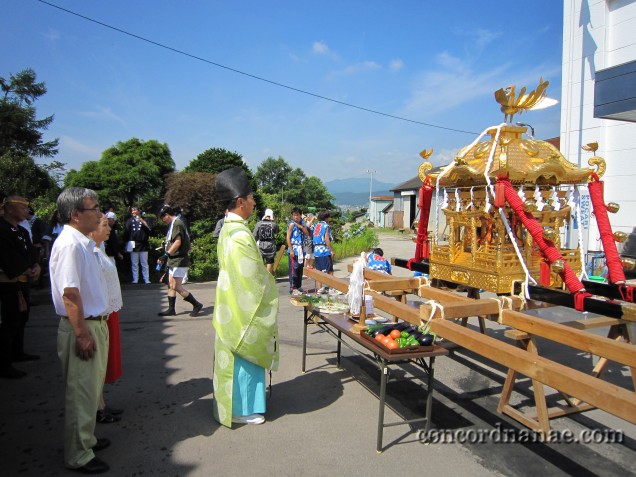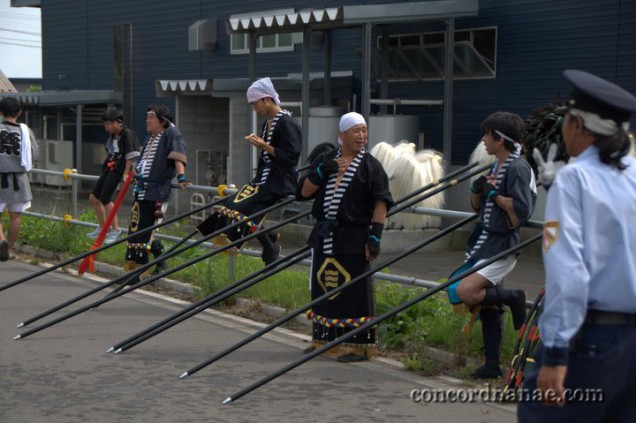By Ben Mirin, CIR
Happy New Year to everyone involved in the Concord-Nanae sister city relationship. I hope you enjoy the video.
By Ben Mirin, CIR
Happy New Year to everyone involved in the Concord-Nanae sister city relationship. I hope you enjoy the video.
Post by Ben Mirin, CIR
Videography by Ben Mirin and Emi Kimura
The following are three short videos shot independently with my iPhone at the Nanae Bunka-sai on October 30th, 2011. These were originally filmed for upload on my live video feed at qik.com/benmirin/videos. However, due to some persistent problems with my account, I am re-posting these videos here. The quality is…well, iPhone quality. Enjoy!
Please consider leaving a comment on this post in the comment section below, or subscribing to the RSS feed to have future articles delivered to your feed reader.
To submit suggestions for future content, please email concordnanae@gmail.com. Thank you for visiting ConcordNanae.org.
By Ben Mirin, CIR
Filming by Emi Kimura
For those of you watching in Concord, “jouzu” means “very good” or “skilled.”
Enjoy the video.
Please consider leaving a comment on this post in the comment section below, or subscribing to the RSS feed to have future articles delivered to your feed reader.
To submit suggestions for future content, please email concordnanae@gmail.com. Thank you for visiting ConcordNanae.org.

By Ben Mirin, CIR
August 8th, 2011
Nanae’s new Assistant Language Teacher (ALT) and Concord native Ben Haydock arrived sweaty and exhausted at Hakodate airport on July 28th. He had a full week of festivities for the Hakodate Port Festival to look forward to, but his true initiation as a member of the Nanae community would not come until the following week.
Five hundred pounds, dripping with golden chains and clamoring bells, Nanae’s O-Mikoshi (mobile shrine) emerges from the stores of Nanae’s Mishima Shrine only once a year, on the shoulders of two-dozen men. At 7:30am on August 8th, Ben and I suited up in traditional happi robes and joined twenty other local volunteers to carry this cherished relic up and down the streets of Nanae for the town’s annual Summer Festival.
“After dancing the Ika Odori (squid dance) in the Hakodate Port Festival, I didn’t entirely know what to expect from Nanae the following week “ Ben said.
“I knew we would be carrying something heavy, but it wasn’t until we started down the street, with the O-Mikoshi in tow, that I realized my role in this festival was more as a laborer than as a carefree festival goer.”
O-Mikoshi all over Japan travel annually among the neighborhoods that worship at the Shinto shrines where they are kept year round. They serve as vehicles for particular Japanese Shinto deities, traditionally believed to reside in the principle shrines themselves. As they are bourn along the avenues of their respective districts, the O-Mikoshi spread good fortune to deferential residents who emerge from their homes and shops to pray and offer donations that support the festival for the following year.

That day our task was to cover all of Honcho, a district in Nanae that proved far larger than either Ben or I had imagined. At eight o’clock sharp, we shuffled into place around the O-Mikoshi’s wooden supports and prepared to march as five pairs of Yakko, or fan-bearers, took their places at the front of the procession. They carried long staves capped with masses of decorative feathers. Two by two they stepped forward and, swooping down to a crouch, swung these ornaments low over the ground with choreographed precision. They were clearing a path for our shrine to travel.

The last of the Yakko moved off, repeating their ritual every few meters. The veteran marchers began shaking the O-Mikoshi enthusiastically to set the mood for the festive procession. This continued for several minutes until a shout came from the front of the group. As one we hoisted the O-Mikoshi over our heads and marched forward from beneath the shade of Mishima’s iconic curving rooftop. Continue reading “Nanae’s Summer Festival: Carrying the O-Mikoshi”
By Ben Mirin, CIR
July 7th, 2011
The drive home from the Yakuba usually takes about two minutes, but this evening was different. At nearly every intersection, Nanae’s rush hour traffic came to a halt as crowds of children in brightly-colored yukata flooded the crosswalks. They rushed to keep time with the changing of the lights, swinging bulky cloth knapsacks and scattering their contents of sweets and little trinkets that clattered like a festive hail on the pavement.
It was a rare spectacle to see Japanese people trying to cheat the flickering crosswalk signs, but I had to pull over into a 7-11 parking lot to learn what could entice them exhibit such outlandish behavior. I got out just as a group of girls emerged from the store peering intently into their bags and nearly tripping over one another to compare their latest payload. They mingled and danced impatiently on the corner until the lights changed, then merged with an oncoming group of mothers and toddlers and raced over to the yakiniku shop across the street. I followed them up to the door, but there was no way to see inside beyond the crowd that had amassed outside, so I waited.
Through the doorway sounds of chanting could be heard, punctuated frequently by the affirming laughter of several deeper, gruff voices inside. Within moments, the children emerged in a rush to meet up with their parents, who had caught up and were waiting just outside. As they moved off and crossed the street again I pushed through the tousled curtains hanging above the doorway and entered the shop. Continue reading “Tanabata Matsuri”
By Ben Mirin, CIR
As seen in the Concord Journal bi-monthly column, “The Japan Connection.”
May 22nd, 2011

Any crowd of foreigners in Hakodate is usually very conspicuous, but in my search for the starting point of this year’s Goryokaku Festival, I knew I had no way of asking for directions. Asking passersby downtown where I could find a crowd of foreigners in 19th century military garb surely would have drawn blank stares.
Now in its 42nd year, the Goryokaku Festival is never complete without foreign volunteers. Festival organizers use word of mouth to recruit them to march as soldiers and flag bearers in the Meiji Restoration Parade. Every year on the Sunday after the third Saturday in May, this huge event commemorates the end of Japan’s Boshin War period with reenactments of the Battle of Hakodate in Goryokaku Square.
“Ben!”
Hearing my name with perfect American pronunciation catches me off guard nowadays. My friend Bill Bowman, a 10-year veteran flag-bearer for the Parade, was waving to me from across the street.
“Let’s go get you into costume,” he said. For the first time, I noticed his mid-western accent, or what was left of it after 16 years of living in Hakodate.
We walked together for a mere five minutes before the clang of Japanese katana and synchronized shouts from reenactment volunteers were clearly audible in the Sunday morning stillness. I passed through crowds of Japanese high school students dressed in the colors of the Meiji and the Tokugawa shogunate armies and ascended the stairs to the costume room.
Upstairs, a man in a shogunate uniform greeted me and gestured to a group of boldly dressed men at the far end of a large tatami room.
Continue reading “Marching in the Meiji Restoration Parade”
By Ben Mirin, CIR
Happy Holidays from ConcordNanae.org!
The following video showcases one of the many performances at the center of Hakodate Christmas Fantasy, a holiday festival that draws crowds from around Hokkaido for a full month of public events and spectacles. The stage shown here is set in front of the city’s tremendous Christmas tree, which was transplanted from Hakodate’s Canadian sister city, Halifax.
After braving whipping winter winds to watch these performances, I would recommend that any visitor to Hakodate Christmas Fantasy head straight for the nearest Ramen shop. These restaurants will likely be less crowded than places like the Hakodate Beer Hall, where I chose to eat my meal. The food (and beer) was delicious, but if you’re not content waiting up to 1 hour for your table then roadside Ramen is the way to go (most places will have some form of indoor seating, whether in the shop or in a retrofitted truck trailer).